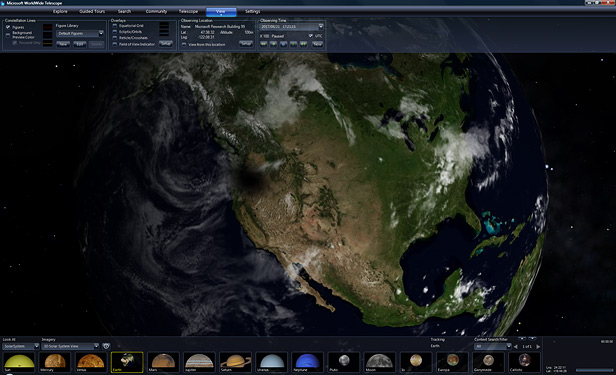A Virtual Telescope Turns Back toward Earth

WorldWide Telescope is a free piece of software that lets people take a virtual tour through the far-flung corners of outer space. It also helps astronomers share scientific data on cosmological phenomena. Now a new plug-in is turning that virtual telescope back toward Earth.
WorldWide Telescope can be downloaded or used in a Web browser. Click on a galaxy or star cluster, and you’ll see properties such as the spectral data and wavelengths emitted by the celestial object in question, in addition to relevant peer-reviewed articles and Wikipedia entries. “Objects in the sky become the hyperlinks themselves,” says Harvard astronomy professor Alyssa Goodman, who has been an active user of the technology since it was unveiled to the public at the TED conference in 2008.
The software is primarily used as a repository for astronomy data, but it also serves as an educational tool. An initiative called the WorldWide Telescope Ambassadors’ Program, led by Goodman, was launched in 2010 to show students what they can’t see with the naked eye.
The new plug-in allows data stored in Microsoft’s Excel document format to be imported and viewed in WorldWide Telescope.
The plug-in has expanded the way researchers are using WorldWide Telescope. For example, time-sequence data showing the spread of Avian flu in 2010 has been uploaded, allowing researchers to see how geographic and climate may have affected the outbreak. Other data shows the accumulation and disappearance of glacial ice in Glacier Bay, Alaska, enabling climate study; and another data set shows the average amount of wind across the topographies of Washington state, which is useful for determining the viability of wind farms.
WorldWide Telescope has been actively used by eight million people in its first three years, says Curtis Wong, a codeveloper and former manager of the WorldWide Telescope project at Microsoft Research in Seattle. The WorldWide Telescope community includes its creators, developers at Microsoft Research, and professional astronomers from multiple universities including Harvard, Johns Hopkins, and Caltech.
Although WorldWide Telescope has so far received little attention outside of the astronomy community, its new Earth possibilities could see it challenge more established geospatial software such as Esri’s ArcGIS.
This article was updated on June 18 to correct that Wong is a former manager of the project.
Keep Reading
Most Popular
How scientists traced a mysterious covid case back to six toilets
When wastewater surveillance turns into a hunt for a single infected individual, the ethics get tricky.
The problem with plug-in hybrids? Their drivers.
Plug-in hybrids are often sold as a transition to EVs, but new data from Europe shows we’re still underestimating the emissions they produce.
What’s next for generative video
OpenAI's Sora has raised the bar for AI moviemaking. Here are four things to bear in mind as we wrap our heads around what's coming.
Stay connected
Get the latest updates from
MIT Technology Review
Discover special offers, top stories, upcoming events, and more.